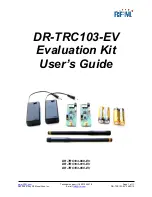
www.RFM.com
Technical s1.800.704.6079
Page 3 of 11
©2009-2010 by RF Monolithics, Inc.
E-mail:
DR-TRC103-EV 04/05/10
The DR-TRC103 radio board LED indicator names and locations are shown in Figure 2.
Figure 2 - DR-TRC103 Radio Board LED Indicators
Table 2 summarizes the functions of the DR-TRC103 connectors, user controls
and LED indicators.
Control/Indicator Designator
Function
I/O Connector
J2
20-pin connector for power and logic signal I/O
Battery Connector
J3
Radio board “battery” power connector, 2.7 to 3.6 V
Battery Power Switch
SW1
On/off switch, in line with the battery connector
Mode Switch
SW2
Used to set the radio mode
Range Switch
SW3
Used to set up range testing and data terminal functions
TX Power Adj Pot
R7
Transmitter power adjustment potentiometer
Antenna Connector
RF-IO
50 ohm antenna connector, standard SMA
Current Monitor Pins
J1
Remove jumper from these pins to measure TRC103 current
Serial/PLL LED
D1
Yellow LED blinks to indicate serial activity and PLL locking
TRC103 SPI LED
D2
Yellow LED blinks to indicate SPI activity to/from the TRC103
Packet Error LED
D3
Red LED blinks to indicate received packet failed CRC check
Good Packet LED
D4
Green LED blinks to indicate received packet passed CRC check
MODE LED
D5
Green/yellow LED color indicates mode of operation
RANGE LED
D6
Yellow LED blinks to indicate range test or data terminal operation
Low Battery LED
D7
Red LED illuminates to indicate low battery (must be configured)
Table 2 - DR-TRC103 Connector, Control and Indicator Functions
Powering the Radio Boards
Two AA battery packs are supplied in the evaluation kit to power the radio boards, as
shown in Figure 3. Alternately, a regulated power supply in the range of 2.7 to 3.6 volts





























